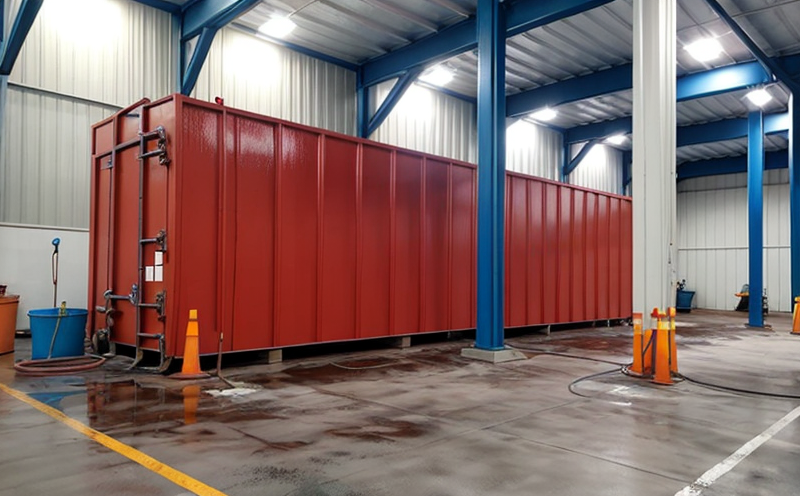ASTM D2486 Scrub Resistance Testing of Paint Films Validation Method Development Test
The ASTM D2486 scrub resistance test is a critical method used to evaluate the durability and performance of paint films under repetitive abrasion conditions. This test ensures that coatings meet the necessary standards for longevity, which is essential in industries where durability and protection are paramount.
The test simulates real-world scenarios where surfaces may be exposed to abrasive forces such as cleaning with a scrub brush or similar actions. By subjecting the paint film to controlled abrasion, this testing method provides an accurate assessment of how well the coating will withstand these conditions over time.
For industrial manufacturing and processing applications, particularly in sectors like construction, automotive, and marine industries, ensuring that coatings perform reliably under harsh environmental conditions is crucial. ASTM D2486 helps manufacturers verify that their products meet required specifications before they reach market or are used in critical applications.
The test procedure involves applying a specified abrasive material against the coated surface at a defined angle and force for a predetermined number of cycles. After each cycle, the amount of removed coating is measured to determine scrub resistance. This process continues until either 25% loss of film thickness or 1000 cycles have been reached.
Developing a robust ASTM D2486 validation method involves several steps:
- Ensuring precise control over the abrasive material and application force
- Maintaining consistent environmental conditions during testing to avoid variability
- Precision measurement of coating thickness before and after each cycle
- Accurate recording and analysis of data collected throughout the test
The primary goal is to establish a reliable method that can consistently reproduce results, allowing for meaningful comparisons between different formulations or samples.
Understanding the ASTM D2486 scrub resistance testing process helps quality managers and compliance officers ensure their products meet regulatory requirements. R&D engineers benefit from this knowledge as they develop new formulas aimed at improving scrub resistance properties. Procurement teams can use it to select suppliers who provide high-quality materials suitable for rigorous durability tests.
By investing in comprehensive ASTM D2486 validation, companies demonstrate their commitment to producing reliable and durable products that meet industry standards and customer expectations.
International Acceptance and Recognition
- ISO/IEC 17025: Laboratories accredited under this standard must adhere strictly to international guidelines for competence in testing and calibration laboratories. This accreditation ensures the highest level of accuracy and reliability.
- ASTM International: The ASTM D2486 test method is widely recognized within the paint and coatings community as a key indicator of a coating's durability against abrasion.
The ASTM D2486 scrub resistance test has gained international recognition due to its stringent protocols and consistent results. Many countries around the world adopt this standard when specifying requirements for industrial paints and coatings, ensuring uniformity across various markets.
By adhering to ASTM D2486, manufacturers can ensure their products are recognized globally, enhancing market access and competitiveness in international trade. The use of internationally accepted standards like ASTM D2486 also fosters trust among stakeholders, including customers, regulators, and investors.
Environmental and Sustainability Contributions
The ASTM D2486 scrub resistance test contributes positively to environmental sustainability by promoting the development of more durable coatings that require fewer replacements over their lifecycle. This reduces waste associated with frequent recoating or replacement due to poor abrasion performance.
Durable coatings also contribute to energy efficiency in buildings and infrastructure, as they reduce maintenance needs and extend service life. Longer-lasting products mean less resource consumption during production processes and lower carbon footprints throughout the product’s lifetime.
By validating scrub resistance according to ASTM D2486, companies can contribute to sustainable practices by ensuring that their coatings perform optimally under real-world conditions, thereby reducing environmental impact through reduced lifecycle costs and extended product longevity.
Competitive Advantage and Market Impact
The ability to demonstrate compliance with ASTM D2486 scrub resistance testing can provide significant competitive advantages in the industrial coatings market. Consumers increasingly seek products that meet stringent quality standards, and being able to showcase adherence to these internationally recognized benchmarks enhances brand reputation.
Companies that invest in robust ASTM D2486 validation methods are better positioned to attract business from clients who prioritize sustainable practices and high-quality performance. This can lead to increased market share and long-term customer loyalty.
In addition, companies that consistently meet or exceed the requirements set out by ASTM D2486 may find themselves at an advantage in negotiating terms with suppliers and partners. They are seen as leaders in their field, driving innovation and setting new industry standards.





